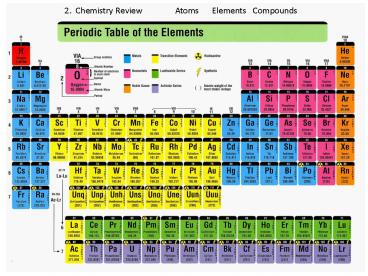2. Chemistry Review Atoms Elements Compounds PowerPoint PPT Presentation
1 / 68
Title: 2. Chemistry Review Atoms Elements Compounds
1
2. Chemistry Review Atoms Elements Compounds
2
(No Transcript)
3
Atoms/Elements versus Compounds ?
4
Atoms/Elements versus Compounds ?
O Atomic Oxygen
Oxygen
Oxygen
O2 Molecular Oxygen
5
(No Transcript)
6
(No Transcript)
7
(No Transcript)
8
Molecular Weight Whats a mole?
9
Or Avagadros Number of ???
10
Molecular Weight of Glucose C6H12O6
6 C x 12 72 12 H x 1 12 6 O x 16
96 MW 180 g/mole
11
Reactions Functional Groups
12
Examples of important acids and their conversion
to salts
13
pH - define
14
From Brocks Biology of Microorganisms, 8
ed.Madigan, Martinko Paker
15
pH define - log (H) -log H in low
ionic strength
16
Acidity of the water and high metal
concentrations can be deadly to animals and
plants inhabiting the receiving streams. Acid
mine drainage coats stream bottoms with iron
hydroxide, giving the subtrates in impacted
streams an orange color.
17
Things that affect Diffusion Ionization Acid
Rain, GI Tract, Ocean
Define pH
18
What is a dissociation constant?
19
Ionization Acid Rain, GI Tract, Ocean
HA ? A- H
?
Ka is acid dissociation constant OR just Acidity
Constant
pKa -log10 Ka
pKa pH at which 50 ionized and 50 unionized
Henderson Hasselbalch Equation Acids pKa
pH Log Unionized / Ionized Bases pKa
pH Log Ionized / Unionized
See next For Benzoic Acid 4.2 7 -2.8, antilog
-2.8 0.002, so about 2 unionized at pH 7
20
OR Why am I not Dead? Hydrogen Sulfide rotten
egg H2S weak acid pKa 7.0 So which more
risky? high pH (sea water) or low pH (acid
rain) Fermentation end products are acidic pH
in Blue Holes lt7.0 so ?
21
Optical Isomers Defintion Example
Importance most sugars are d (dextro) most
amino acids are levo (l)
Everything, except of course a vampire, has a
mirror image
22
(No Transcript)
23
Structures of Some Biologically Important
Molecules
24
Components of Life Sugars
Lactose
25
Carbohydrates
26
Lipids
Fatty acids
Triglycerides
27
Triglycerides
28
Phospholipids
29
Special Types of Lipids
30
Important Lipid Types
31
(No Transcript)
32
(No Transcript)
33
Proteins and Amino Acids
Basic Structure of Amino Acids
The R can be a H, a methyl group, sulfur,
aromatic ring, etc.
34
Peptide Bond
35
Functions of Proteins and Amino
Acids Enzymes Types Kinases energy
production Phosphatases transfer phosphate
groups Oxidoreductases transfer
electrons Dehydrogenases electron transport
Transferases- group transfer reactions Lyases
add to double bonds or form them Isomerases
change isomeric configuration Ligases form C-C
, C-S, C-N, and C-O bonds
36
Typical co-factors often contain vitamins eat
your leafy veggies!
37
NAD and NADP nicotinamide and nicotinamide
phosphate FAD flavin adenine dinucleotide
(riboflavin -vitamin B2) Coenzyme A contains
panothenic acid (vitamin) Pyridoxyl phosphate
(vitamin B6)
38
Energy Storage and Transfer NAD and ATP
Brock .11th, Fig 5.12, p116
ATP
39
Transport of materials within and from and into
the cell (active transport)
Source I. Mijakovic, 2010. Protein
phosphorylation in Bacteria, Microbe 521-25.
40
Structure
Membranes, DNA, etc.
Nucleic Acids
41
(No Transcript)
42
(No Transcript)
43
Protein backbone histones in eykaryotic
cells Functions RNA Switches
Three major types ribosomal, messenger,
transfer Function to form proteins
44
DNA Contains genetic material in chromosomes of
within the nuclear membrane in
Eukaryotes in the nucleosome of Prokaryotic
cells
45
Some Analytical Techniques Chromatography
Paper, Thin-layer, Gas, High Performance
Liquid, Column Mass spectrometry
46
Packed Column
Gas Chromatograph
Capillary Column
47
(No Transcript)
48
Mass spectrometry
49
3. What is BIOLOGY? What constitutes life?
50
A Cell Composition Phospholipid membrane
51
(No Transcript)
52
(No Transcript)
53
(No Transcript)
54
Prokaryote Cell
55
Hierarchy Organelles Cell (single or
multi) Metabolism Tissue Organ Organ
system Organism Population Community Ecosy
stem
56
Evolution Random Natural Selection Adaptatio
n Lateral Transfer Genetic Drift Divided
populations develop different traits randomly
57
Geological time can lead to Divergent Evolution
Bottleneck Effect Loss of a significant part of
the population
58
Example of the eye
59
Extinction Natural Man made
60
Taxonomy Basis Order of Things King Phillip Came
Over From Greece Saturday
61
(No Transcript)
62
Three Domain System
Carl R. Woese
From bacteria and Archaea
Oldest 3.5 billion years
Archaea Ether bonds in membranes no
peptidogycan
Bacteria likely
16S rDNA showed Archaea differ from Bacteria
63
Geological Time and the Development of Life
64
Interactions with the Environment Temperature
and Light
65
For Organisms Generally Vant Hoffs Law Incgt
10oC 2 X growth Q10 2
Cardinal Temps Minimum Maximum Optimum
66
Temperature range -1.8 to 113oC (maybe 121oC
Pyrodictium sp.) Above 100oC must be under
pressure life depends on liquid water Each has
Optimum (lab measured), Range Psychrophiles OT
lt 15oC (deep Ocean, winter arctic) Mesophiles
- OT 25 40/5oC Thermophiles - OT 40 60oC
(compost, hot springs, HT vents) Hyperthermophile
s OT gt 80oC
Pseudoalteromonas Acrtic ocean
67
Oxygenic Photosynthesis Light Reaction
68
(No Transcript)

